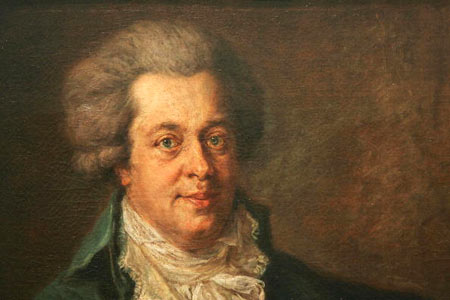Wolfgang Mozart (1756-1791)
Born January 27, 1756 in Salzburg, Austria.
Died December 5, 1791 in Vienna, Austria.

Overture to Die Zauberflöte K. 620
Composed 1791.
First Performance: September 30, 1791 at the Theater auf der Wieden (Freihaustheater), Vienna conducted by Mozart.
Instrumentation: 2 flutes, 2 oboes, 2 clarinets, 2 bassoons, 2 horns, 2 trumpets, 3 trombones, timpani, and strings.
On December 5, 1791, Wolfgang Amadeus Mozart died from poisoning. He was working on a Requiem Mass (K. 626) commissioned by a mysterious cloaked stranger whom Mozart regarded as a vision of his own death. He was being assisted in writing the Requiem on his deathbed by his poisoner – the mediocre composer Antonio Salieri who hired the cloaked stranger and who wanted to pass the work off as his own.
A raging blizzard on the day of his funeral (December 6) forced the handful of mourners gathered at St. Stephen’s to turn back at the city gates. His wife Constanze had money for neither a coffin nor a proper burial site so Mozart was thrown into a pauper’s grave “together with the remains of outcasts, vagrants, and the riff-raff of the Austrian capital.”
Peter Shaffer’s 1984 movie Amadeus (and 1979 play) is thoroughly entertaining – and thoroughly inaccurate. Shaffer was not the first to dramatize these myths. Alexander Pushkin (1799-1837) wrote a one act play in 1830 entitled “Mozart and Salieri” which he originally termed a ”dramatic investigation.” In 1898 Rimsky-Korsakov (1844-1908) turned Pushkin’s play into an opera.
The myths arose almost immediately after Mozart’s death; many were intentionally started by Constanze. Towards the end of his life Salieri lost his reason and was institutionalized. His claims to be Mozart’s poisoner at this point added fuel to that myth.
It was Count Franz von Walsegg who actually sent the messenger. His wife had recently died and it was he who wanted to pass the Requiem off as his own. Mozart was buried in the cheapest available grave – a communal grave and not a pauper’s grave. Emperor Joseph II issued an edict that funeral observances should not be ostentatious and for sanitary reasons the deceased should be buried together outside the city limits.
The best guess from modern physicians is that Mozart died from what is now called Rheumatic Fever and not arsenic poisoning.
In 1960 musicologist Nicolas Slonimsky (1894-1995) put an end to the blizzard myth by simply writing to the Vienna Weather Bureau for the records for the burial day: “Mild, drizzle, 5 degrees [centigrade]. No blizzard.”
Die Zauberflöte (The Magic Flute) was Mozart’s last opera. Actually he interrupted its composition in July 1791 by writing an opera seria – La clemenza di Tito, K. 621 – and completed it only after the latter’s premiere.
The Magic Flute is a singspiel which is similar to modern Broadway musicals where spoken dialog and singing alternates. It was commissioned by impresario Emanuel Schikaneder who wrote the libretto and also played the part of Papageno.
The custom of opera overtures setting the mood of the action or previewing the big tunes did not become common until well after Mozart’s time. The overture begins with a brief adagio introduction. The allegro that follows is similar to his Jupiter Symphony where fugal techniques are applied to a sonata form. The subject is first presented by the second violins.
The four part fugal exposition continues with the second violins offering glimmers of a counter subject before the first violins present it in its entirety while the subject is played in the lower strings. From this simple material weaves a remarkable contrapuntal tapestry where these materials are subjected to many variations including double counterpoint. The exposition ends with a brief codetta and settles on a unison B flat.
The opening chords return, played twice now, before the allegro returns to signal the beginning of the development section. We hear more extensive contrapuntal re-workings of the fugal subject and counter subject including a few canons. The recapitulation begins but we don’t hear the entire subject right away. We recognize it as a recapitulation but Mozart was much too skilled to offer a simple repeat of the opening.
There is a coda that resembles the closing codetta of the exposition but is more extensive. The addition of the brass brings the overture to a brilliant finish.
Resources
[amazon template=iframe image&asin=B00009KHYD]
[amazon template=iframe image&asin=048624783X]
[amazon template=iframe image&asin=B002GTZSZU]
Public domain scan of the score.
